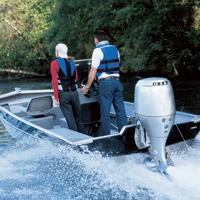All of the shiny (and not-so-shiny) stuff that’s bolted to your boat is called hardware.
Nuts & Bolts
Fasteners are the screws, nuts and bolts that attach the various pieces of hardware to your boat. Due to their corrosion resistance, stainless steel fasteners are recommended over the bright-finish screws, bolts, and nuts from your local home-improvement store.
The term “through-bolted” means that an item of deck hardware is held in place with a bolt (or long machine screw) that goes all the way through the deck. Under the deck, a washer and nut are threaded on the bolt, and tightened with a wrench to hold the piece of deck hardware firmly in place.
Rub Rail
- One of the most cost-effective ways to freshen up an older boat’s appearance is to replace the rub rail—the narrow “bumper” that goes all the way around your boat, usually at the place where the hull meets the deck.
- Taking the old rub rail off isn’t difficult; it’s usually just a matter of removing dozens of screws that hold the rub rail on the boat. A couple of suggestions here—a cordless drill with a screwdriver bit works great for screw removal, and—those screws have been in place for a long time, so be careful not to break them off or damage the screw heads when you’re backing them out.
- Installing the new rub rail is really a two-person job—again, not particularly hard, but having a second set of hands to help hold the rub rail in place is invaluable.
- To gain insights to the secrets of rub rail installation, one of the instructional books/CDs/DVDs that are on the market can walk you through the process step-by-step.
Cleats
- Cleats provide a place to attach dock lines and fenders. It’s rare to have a cleat actually fail; more often than not, the fasteners holding the cleat to the deck work loose—or come out altogether.
- If the cleats on your boat wiggle at all, you need to break out your tool kit and try to re-tighten the cleat’s fasteners. Remember to use a wrench or ratchet and socket to tighten the nuts under the deck if the cleats are through-bolted.
- In assessing the loose-cleat scenario, if the cleats are starting to pit, rust, or otherwise be showing their age, you may want to think about swapping those old cleats out for new ones. Cleat replacement is a bit more time-consuming than it sounds, and you’ll need another person to help with those hard-to-reach fasteners under the deck—so plan accordingly.
Walk-thru Windshields
- Another hardware situation that’s within the realm of the do-it-yourself boat owner is fixing a droopy walk-thru windshield. If the center glass panel doesn’t want to close properly, chances are that the windshield fasteners and supports aren’t as tight as they should be.
- You might be able to correct this situation by re-tightening the fasteners and re-adjusting the windshield supports (located on either side of the walk-thru section). It’s possible that the windshield supports aren’t adjustable—in that case, replace the supports with new windshield adjusters to help hold the windshield in place.
Form Follows Function
The bottom line is that deck hardware is more than eye-candy—each piece of hardware has a job to do—and with a little upkeep, it’ll last as long as the rest of your boat.
